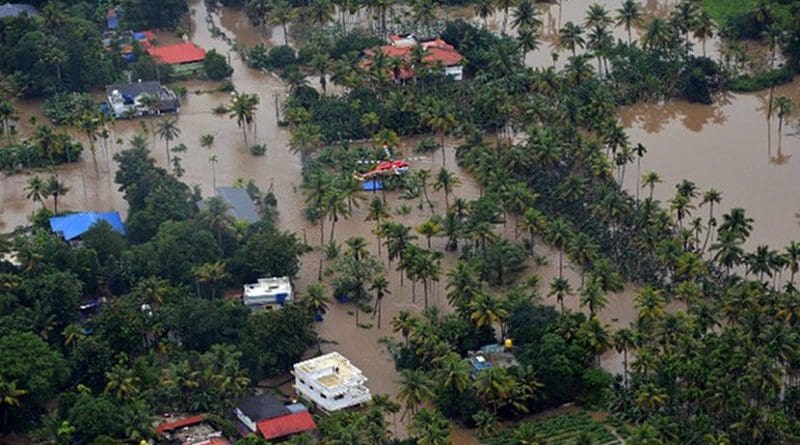India’s Soaring Economy Unveils Floods And Inequality – OpEd
India is now one of the key economies with the quickest growth rates in the world because of its incredible economic development. However, below this economic prosperity, its varied people continue to experience significant gaps and inequality. These problems have recently come to light as a result of a number of floods that occurred across the nation, underlining the critical need for inclusive and sustainable development plans.
India’s infrastructure and regional development are put to the test by floods, with rural areas frequently bearing the burden of poor drainage systems, scant flood protection measures, and ineffective disaster management systems. The differences between urban and rural areas are made worse by the neglect of rural development, leaving rural populations ill-prepared to deal with the destruction wrought by natural disasters.
India’s economic expansion has been characterised by an unequal distribution of its advantages, which has resulted in a concentration of prosperity in select urban regions and among particular income groups. Communities are devastated by floods, and the already impoverished marginalised groups in society struggle much more to recover and rebuild. The worsening of economic inequalities impedes the advancement of people in need and feeds a vicious circle of vulnerability.
Access to basic necessities like food, clean water, healthcare, and shelter becomes a vital factor in determining a person’s chance of survival and recovery during floods and other catastrophes. Due to socioeconomic constraints, disadvantaged populations have more difficulty accessing these resources, which increases their susceptibility to the effects of natural disasters. Recovery efforts are prolonged and socioeconomic inequities are exacerbated by insufficient access to necessary resources.
Communities residing in low-lying areas or unofficial settlements are disproportionately impacted by large-scale displacement brought on by floods. Forced migration causes livelihoods to be disrupted and makes these populations more socioeconomically vulnerable. The search for alternative housing and employment options prolongs the recovery process and widens the gap between those who have resources and others who are trying to start over.
Floods have a greater impact on marginalised communities as a result of climate change since these groups frequently lack the means and resilience needed to adapt to these shifting environmental circumstances. Marginalised communities face the brunt of the impact when extreme weather events increase in frequency and intensity due to climate change, demanding specific support and climate resilience measures.
To ensure inclusive resilience in the face of natural disasters, India’s social safety net programs need bolstering. A more comprehensive and targeted approach is necessary to provide timely and sufficient support for vulnerable populations affected by floods. Strengthening social safety nets can serve as a buffer, offering assistance to those who have lost their homes, livelihoods, and belongings, promoting a more equitable recovery process.
India’s approach to addressing the issues of economic inequality and vulnerability to natural disasters, particularly among marginalized communities, has been subject to criticism on several fronts:
Inadequate Emphasis on Rural Development: The nation’s economic growth has disproportionately favored urban areas, while rural regions continue to face infrastructural inadequacies, insufficient flood protection measures, and ineffective disaster management systems. This neglect of rural development leaves rural populations ill-prepared to cope with the destructive impacts of natural disasters.
Uneven Distribution of Economic Benefits: Despite impressive economic expansion, the benefits have been concentrated in select urban regions and among specific income groups, resulting in a widening wealth disparity. This exacerbates the challenges faced by disadvantaged communities in recovering from the repercussions of floods and other calamities.
Limited Access to Resources for Vulnerable Communities: Socioeconomic constraints hinder disadvantaged populations from accessing fundamental necessities such as food, clean water, healthcare, and shelter during floods and other crises. This lack of access intensifies their vulnerability to natural disasters and prolongs the recovery process.
Neglect of Low-Lying and Informal Settlements: Vulnerable communities residing in low-lying areas or informal settlements bear a disproportionate burden of floods and forced migration. Inadequate housing and employment options further compound their socio-economic vulnerability, hindering their ability to rebuild their lives after disasters.
Insufficient Climate Resilience Measures: With climate change exacerbating the impact of extreme weather events like floods, marginalized communities often lack the means and resilience to adapt to changing environmental circumstances. India’s efforts in implementing climate resilience measures and providing targeted support to vulnerable groups need improvement.
Reactive rather than Proactive Disaster Management: The description highlights poor drainage systems, scant flood protection measures, and ineffective disaster management systems in rural areas. A more proactive approach to disaster management is necessary to reduce the impact of floods and protect vulnerable communities.
Limited Social Safety Nets: Economic disparities result in vulnerable populations having limited access to adequate social safety nets during and after disasters. Strengthening social safety net programs is imperative to support those most affected by floods and other crises. Collecting the facts, India’s commendable economic growth notwithstanding, addressing the challenges of economic inequality and vulnerability to natural disasters requires a more comprehensive and targeted approach.

